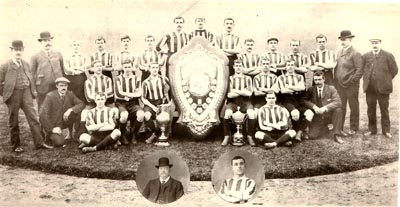
sheriff of london shield
Introduction Many Sunderland fans over the years have been intrigued about a famous shield won by the club at the beginning of the century. The Sheriff of London Shield stands over 6 foot high and is one of the largest trophies ever competed for in professional football. Here is the story of this massive trophy and why it should have a special place in the hearts of all Sunderland supporters. _____________________________ Background The first Shield was played for in the 1897/98 season, March 19 to be exact, and was meant as an annual charity game between the best amateur team of the year and the best professional outfit. In 1908 it would evolve into the charity/Community shield that we know today as the pre seaosn curtain raiser between the league champions and cup winners. A trophy was offered by Sir Thomas Dewar, who formed a committee and drew up appropriate regulations. Initially the competition was a great success, with money raised from the annual fixture distributed to hospitals and other charitable institutions. Whilst in the allocation of the various amounts London charities received the greater portion, a certain amount was always distributed among the charities of the town which the professional team taking part in the competition represents. Sunderland would have benefitted in someway from its football team taking part. Strangely Corinthians, who instigated the competition were actually inelgiible due to its own regulation number 7 which stated that "the club shall not compete for any challenge cup or prizes of any description whatever." With regulations duly amended the original committee was formed as follows: Sir Thomas Dewar (donor), Lord Kinnaird (president), Sir Reginald Hanson, Bart., MP, Sir Francis Marindin, KCB, W. Bromley Davenport, Esq., MP, H. McCalmont, Esq., MP, R. C. Gosling, Esq., Dr. Kemp, N. L. Jackson, Esq., J. J. Bentley, Esq., C. Wreford-Brown, Esq.— _____________________________ The Match
Corinthians v Sunderland On February 28 1903 Sunderland, being League champions the previous season played Corinthian Casuals, as they were then known, at White Hart Lane Tottenham. The teams selected were:— Corinthians.—G. E. Wilkinson (goal); Rev. W. Blackburn, W. U. Timmis (backs); P. P. Braithwaite, M. Morgan - Owen, H. Vickers (halves); M. H. Stanbrough, R. Corbett, R. G. Wright, C. F. Ryder, B. O. Corbett (forwards). Sunderland.—Doig (goal); McCombie, Watson (backs); Farquhar, McAllister, Jackson (halves); Hogg, Robinson, Miller, Hewitt, Bridgett (forwards). Referee.—Mr A. Green. The official Corinthians handbook from 1905 gives the following match report: "With little or no grass to be seen, and the surface in a greasy condition, accurate passing and kicking became very difficult. Still, these conditions appeared to affect the professionals but little, and they gave a display of collective excellence from start to finish, and won by 3 v 0. The Corinthian back division played with Vickers, Blackburn, and Braithwaite continually breaking up the combination of the Sunderland forwards, who were very ably led by Miller in the centre. But the amateur forwards were an untried combination; they had not played together before, and they proved totally ineffective as a whole. Occasional individual breaks caused some anxiety to the Sunderland defence, but before the game was many minutes old it was plain that the amateurs were not likely to fall in with one another's play or show any cohesion in attack. The professional backs were complete masters of the situation from: start to finish, and it really reflected great credit upon the Corinthian defence that they only allowed three goals to be scored against them". Lord Kinnaird, President of the Football Association, presented the medals and shield to the winning side. _____________________________ Research Around about 1907/08 season there was a rift within the FA relating to the status of amateurs and professionals (a debate which incidentally stopped the home countries from taking part in the World Cup until 1950). The FA split into 2 bodies, the FA and the AFA. This resulted in the FA forming their own Charity competition, The FA Charity Shield, or Community Shield as we know it today, and the amateur version was, after a bright start, condemned to take a back seat. The trophy has never seen the light of day since and 6 requests for it to be shown at football exhibitions, have fallen on deaf ears. No reason has been given as to why. For example the FA tried to get it for their Euro '96 exhibition in Manchester but were refused. 1998 commemorated the centenary of both Roker Park and the Shield. So what we have here is the forerunner of the FA Charity Shield but unfortunately, despite it being an awesome trophy, it is extremely doubtful whether a wider footballing public will ever get to see it again. _____________________________
|
